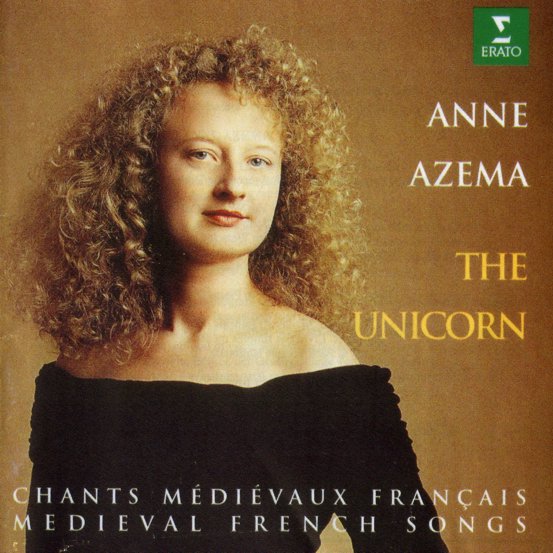
Anne Azéma • Boston Camerata
amazon.com • medieval.org
Erato 4509 94830-2
mayo de 1993 (53 ')
• LE BESTIAIRE D'AMOUR •
01 - Philippe de THAON. Serena en mer hante [2:10]
Anne, Cheryl Ann, Shira (harp)
02 - En mai au douz tens nouvel [3:58]
Ann, Jesse, Cheryl Ann
03 - Issi avint qu'un cers [2:06]
Anne, Shira
04 - D'un gupil [1:17]
Anne, Shira
05 - La danse de Gupil [1:35]
Shira
06 - Ensement com la panthere [4:23]
Anne, Cheryl Ann
07 - Philippe de THAON. Monosceros est beste [1:06]
Anne, Shira
08 - Thibault de CHAMPAGNE. Aussi come unicorne sui [6:12]
Anne, Shira
• MIRACLES ET MERVEILLES •
Le cycle de St. Leochade
09 - Que de memoyre [1:47]
Anne
10 - Las, las, las [3:56]
Anne, Shira (harpe)
11 - Quatre jours plains [1:30]
Anne, Cheryl Ann
12 - Sour cest rivage [4:07]
Anne, Cheryl Ann, Shira
13 - N'est pas merveille [1:32]
Anne
14 - Gauthier de COINCY. De sainte Leochade [5:59]
Anne, Shira (harpe), Jesse
• L'ABBAYE d'AMOUR ou L'AMOUR FAUSEIE •
15 - Au renouvel [3:11]
[a) an. s.XIII] Jesse, Cheryl Ann, Shira
[b) Shira Kammen] Cheryl Ann, Shira
16 - Belle Doette [8:44]
Anne, Jesse
17 - Je chevauchoie l'autrier [3:19]
Anne, Shira, Cheryl Ann
Anne Azéma, voice
Cheryl Ann Fulton, harpes
Shira Kammen, vielle, rébec, harpe
Jesse Lepkoff, flûte
This program of old French music and poetry explores a very important but-little known aspect of the Middle Ages: the art of story-telling.
Centuries ago, the frontier between the musical and literary worlds was much less sharply drawn than today. This recording focuses on French narrative art, both religious and secular, from the late eleventh to the early thirteenth centuries. unicornThe recording begins with a lovers' Bestiary. In medieval times, animals both real and mythical were used to represent the various states of the human psyche: the works we perform tell of the sorrows of love (the panther), of treason and death (the unicorn), of vanity (the stag), of pride (the fox). We include simple songs (the nightingale), narrative recitations (Marie de France, the twelfth century poetess), and some of the more elaborate trouvère songs: one of these, Thibaut de Champagne's song of the unicorn, develops all the "secret" themes of courtly love, its joys and its tribulations, perils and hopes.
Gauthier de Coincy (1177-1236), prior of Vi sur Aisne, was a prolific author of religious poetry and music. Among his "Miracles of Our Lady," we have selected the cycle of Sainte Leocade (in its American première). The poems and songs tell the story of a holy statue stolen and then found in the Aisne, thanks to the intercession of the Virgin. Gauthier's text is rich in vivid images, and his melodies are among the most beautiful of the period.
The last part of this program focuses on women's texts. The "weaving song," Belle Doette, tells the romanticized story of a maiden whose lover is killed in a joust; the girl then creates the "abbey of love" where all disappointed lovers may go to escape the world. We then meet a dame de Paris, anxious to abandon a husband who beats her for the young gallant she has just met.
The songs and texts are framed by instrumental interludes, based on tunes of the French trouvères.
Reediciones:

